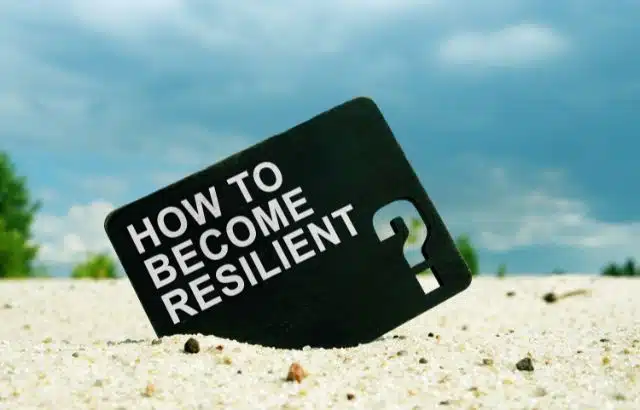Mental Health
Coaching Techniques for Overcoming Challenges

Resilience, the ability to bounce back from adversity and maintain a positive outlook despite difficulties, is a crucial skill in both personal and professional realms. As a coach, helping clients build resilience can significantly impact their overall well-being and success. This article delves into the essence of resilience, the challenges people face, and coaching techniques to foster resilience in clients.
Understanding Resilience
Resilience is not an inherent trait but a skill that can be developed. It encompasses emotional strength, mental toughness, and the ability to adapt to changing circumstances. Resilient individuals can handle stress more effectively, recover from setbacks quickly, and maintain a sense of control over their lives.
The Importance of Resilience
In today’s fast-paced and ever-changing world, resilience is more important than ever. Whether dealing with personal loss, professional setbacks, or everyday stressors, resilience enables individuals to navigate through challenges without succumbing to negative emotions or mental health issues. For coaches, helping clients build resilience means empowering them to face life’s ups and downs with confidence and strength.
Common Challenges Faced
Before diving into coaching techniques, it’s essential to understand the common challenges clients may face:
- Stress and Anxiety: High levels of stress and anxiety can be overwhelming and hinder an individual’s ability to cope with everyday tasks.
- Fear of Failure: Fear of failure can paralyze individuals, preventing them from taking risks or trying new things.
- Lack of Confidence: Low self-esteem and lack of confidence can make it difficult for individuals to believe in their abilities and achieve their goals.
- Negative Thought Patterns: Persistent negative thoughts can undermine an individual’s efforts and lead to a cycle of self-doubt and helplessness.
- Burnout: Prolonged stress and overworking can lead to burnout, resulting in physical and emotional exhaustion.
Coaching Techniques for Building Resilience
To help clients build resilience and overcome these challenges, coaches can employ various techniques:
1. Cognitive Behavioral Coaching (CBC)
Cognitive Behavioral Coaching (CBC) is an approach that helps clients identify and change negative thought patterns and behaviors. By challenging irrational beliefs and replacing them with positive, constructive thoughts, clients can develop a more resilient mindset.
Steps in CBC:
- Identify Negative Thoughts: Encourage clients to recognize and record their negative thoughts and the situations that trigger them.
- Challenge Irrational Beliefs: Help clients analyze the evidence for and against their negative thoughts, encouraging a more balanced perspective.
- Replace with Positive Thoughts: Guide clients to replace negative thoughts with positive affirmations and constructive beliefs.

2. Goal Setting and Action Planning
Setting clear, achievable goals and creating action plans can enhance resilience by providing clients with a sense of purpose and direction. This technique helps clients focus on what they can control and take proactive steps toward their objectives.
Steps in Goal Setting:
- Define SMART Goals: Ensure goals are Specific, Measurable, Achievable, Relevant, and Time-bound.
- Break Down Goals: Divide larger goals into smaller, manageable tasks to avoid overwhelm and maintain motivation.
- Monitor Progress: Regularly review progress with clients and adjust action plans as needed to keep them on track.
3. Mindfulness and Stress Management
Mindfulness techniques can help clients manage stress and stay present in the moment. By cultivating mindfulness, clients can develop greater emotional regulation and resilience in the face of adversity.
Mindfulness Practices:
- Breathing Exercises: Teach clients deep breathing techniques to calm their minds and reduce stress.
- Meditation: Encourage regular meditation practice to enhance focus, clarity, and emotional stability.
- Mindful Journaling: Suggest clients keep a journal to reflect on their thoughts and feelings, promoting self-awareness and insight.
4. Building a Support Network
Encouraging clients to build and maintain a strong support network is vital for resilience. A supportive network provides emotional support, advice, and encouragement during challenging times.
Steps to Building a Support Network:
- Identify Key Relationships: Help clients identify individuals who can offer support, such as family, friends, colleagues, or mentors.
- Encourage Communication: Advise clients to communicate openly and regularly with their support network, sharing their challenges and successes.
- Join Support Groups: Suggest joining relevant support groups or communities where clients can connect with others facing similar challenges.
5. Developing Self-Compassion
Self-compassion involves treating oneself with kindness and understanding during times of failure or difficulty. Encouraging clients to practice self-compassion can reduce self-criticism and foster a more resilient attitude.
Practices for Self-Compassion:
- Self-Reflection: Encourage clients to reflect on their experiences and treat themselves with the same compassion they would offer a friend.
- Affirmations: Guide clients to create positive affirmations that reinforce self-worth and resilience.
- Self-Care: Promote regular self-care activities, such as exercise, hobbies, and relaxation, to maintain physical and emotional well-being.
Case Study: Applying Resilience Coaching Techniques
Consider a client, Jane, who is struggling with work-related stress and a recent personal loss. Through resilience coaching, Jane’s coach employs the following techniques:
- Cognitive Behavioral Coaching: Jane identifies her negative thoughts, such as “I’ll never be able to handle this,” and replaces them with positive affirmations like “I have the strength to overcome challenges.”
- Goal Setting and Action Planning: Jane sets a goal to manage her workload more effectively by delegating tasks and prioritizing self-care.
- Mindfulness and Stress Management: Jane practices daily meditation and deep breathing exercises to reduce stress and improve focus.
- Building a Support Network: Jane reaches out to her family and friends for support and joins a support group for individuals coping with loss.
- Developing Self-Compassion: Jane practices self-reflection and creates affirmations that remind her of her resilience and worth.
Conclusion
Building resilience is a transformative process that can significantly enhance an individual’s ability to navigate life’s challenges. As a coach, employing techniques such as Cognitive Behavioral Coaching, goal setting, mindfulness, support network building, and self-compassion can empower clients to develop resilience and thrive despite adversity. By guiding clients through these practices, coaches play a pivotal role in helping them achieve lasting personal and professional growth.
Mental Health
How to Build Resilience and Overcome Life’s Challenges

Life is full of unexpected twists and turns, and facing challenges that can sometimes feel overwhelming. Whether it’s navigating personal struggles, work pressures, or unforeseen setbacks, we all go through moments that test our strength. But here’s the good news: resilience, the ability to bounce back, is not something you’re born with—it’s a skill you can build and strengthen over time. One powerful and enjoyable way to support that process is by exploring hobbies that reduce stress, which can boost your mental health while helping you cope with life’s ups and downs.
This post will guide you through practical ways to build resilience, offering tools and insights for managing stress, staying optimistic, and moving forward with confidence. Together, we’ll explore how to face life’s challenges head-on and come out stronger on the other side. No matter your starting point, resilience is within reach!

What Is Resilience and Why Does It Matter?
Resilience is the ability to adapt, recover, and thrive in the face of challenges, setbacks, or adversity. It’s not about avoiding difficult situations but learning how to cope with them in a healthy and constructive way. Think of resilience as a muscle that strengthens the more you use it.
Why does it matter? Because life often presents obstacles, whether they’re personal struggles, work pressures, or unexpected crises. Resilience helps you stay grounded during tough times, enabling you to manage stress, maintain focus, and make better decisions. It’s the foundation that allows you to heal, grow, and even find opportunities in setbacks.
Beyond navigating challenges, building resilience contributes to overall well-being. It fosters emotional strength, cultivates a growth mindset, and boosts self-confidence. Resilient individuals often feel more in control of their lives, which leads to greater happiness and success.
The good news? Resilience isn’t an innate trait; it’s a skill you can build over time through self-awareness, supportive relationships, and consistent practice. By developing resilience, you empower yourself to face life’s challenges with courage and emerge stronger each time.
Practical Steps to Build Resilience in Everyday Life
Strengthening resilience doesn’t require a complete life overhaul; small, consistent actions can make a big difference. Start by setting realistic goals. Break challenges into manageable steps, and celebrate progress, no matter how small. This boosts confidence and helps keep you moving forward.
Prioritize self-care. Sleep, exercise, and proper nutrition are the foundation of emotional and mental well-being. When you take care of your body, your mind becomes more resilient during tough times. Equally important is finding moments of relaxation, whether through meditation, journaling, or simply enjoying a favorite hobby.
Building a support network is another key step. Surround yourself with people who listen, encourage, and uplift you. Share your struggles and lean on trusted friends or family when you need extra support.
Lastly, focus on maintaining a positive outlook. While it’s natural to feel stress or frustration, try to reframe challenges as opportunities to grow. Practice gratitude daily to shift your focus toward what’s going well.
By trying out these practical steps into your daily routine, you can build resilience and face life’s difficulties with greater confidence and strength.
How Stress Management Boosts Your Resilience
Managing stress is a critical component of building resilience. When stress goes unchecked, it can overwhelm your ability to cope, leaving you feeling stuck or drained. Effective stress management, however, helps you stay balanced, think clearly, and make better decisions during difficult times.
One key stress management tool is mindfulness. Practicing mindfulness allows you to focus on the present moment instead of worrying about the past or future. Deep breathing exercises, meditation, or simply pausing to check in with your thoughts can reduce stress levels and improve emotional control.
Time management is another practical strategy. Organizing your day with realistic goals and priorities prevents overwhelm and gives you a sense of accomplishment. Taking charge of your time helps you feel more in control, even when life feels chaotic.
Relaxation techniques like yoga, stretching, or even listening to calming music can also counteract stress. These activities calm your body and mind, helping you recover faster from tension.
By mastering these skills, you’ll handle stress more effectively, which strengthens your resilience and prepares you to face challenges with greater ease and determination.
Conclusion
Resilience is the key to navigating life’s challenges and coming back stronger. By applying the strategies that we shared, like managing stress, focus on positivity, and prioritizing self-care, you can build the inner strength to grow. Remember, resilience is a skill you can develop. For more support, insights, and inspiration, explore our full collection of mental health articles designed to help you take steady, empowering steps forward. Start today, and transform obstacles into opportunities for growth.
Mental Health
How Hobbies Can Transform Your Mental Health

In today’s fast-paced world, finding balance can feel like an elusive goal. Yet, hidden within our daily routines and often overlooked amidst life’s hustle and bustle, are hobbies – those small, enjoyable activities that have the power to profoundly impact our mental health and overall well-being.
The Link Between Hobbies and Mental Health
Engaging in hobbies is more than just a pastime; it’s a meaningful way to reduce stress and anxiety. Picture this – you’ve had a long, exhausting day, and as you sit down with your knitting needles or pick up your guitar, the knots of tension start to unwind. This isn’t merely anecdotal; science backs it up. Studies show that hobbies can trigger the release of endorphins, the body’s natural stress relievers, providing a much-needed escape from daily pressures.
Furthermore, hobbies play a crucial role in preventing and managing mental health conditions. Whether it’s gardening, painting, or playing sports, these activities offer a therapeutic avenue to channel emotions and foster a sense of accomplishment. For individuals battling depression or anxiety, hobbies can be a lifeline, offering structure, purpose, and a break from negative thought patterns.
Types of Hobbies That Promote Mental Wellness
Variety is the spice of life, and when it comes to hobbies, there’s something for everyone. Physical activities like yoga, hiking, and dancing not only keep the body fit but also enhance mental clarity and mood. These activities promote the release of serotonin, a neurotransmitter that contributes to feelings of happiness and well-being.
Creative pursuits such as painting, writing, and crafting provide an outlet for self-expression and emotional release. Engaging in such activities can be meditative, helping to quiet the mind and focus on the present moment. Additionally, learning new skills – whether it’s picking up a new language, cooking, or coding – stimulates the brain, keeping it active and engaged while boosting self-esteem and confidence.

Personal Stories and Anecdotes
Consider Sarah, a high-powered executive who turned to gardening as an escape from her high-stress job. Initially seeking a hobby to fill her weekends, she discovered that tending to her plants provided a therapeutic sanctuary. The simple act of nurturing life brought Sarah immense peace, helping her manage work-related stress and improve her overall mental health.
Then there’s James, who found solace in painting after the loss of a loved one. What began as a casual interest soon became his preferred method of coping with grief. Each stroke of the brush allowed him to process his emotions and find a path to healing. These personal stories highlight the transformative power of hobbies on mental well-being.
Tips for Incorporating Hobbies into Daily Routine
Finding the right hobby can be a delightful adventure. Start by reflecting on activities that spark joy or pique your curiosity. Don’t be afraid to experiment with different hobbies until you find one that resonates with you. Overcoming barriers such as time constraints or self-doubt is essential. Remember, you don’t need a large time commitment to enjoy the benefits of a hobby – even 15-20 minutes a day can make a significant difference.
Once you’ve found your hobby, make it a priority. Schedule it into your daily routine as you would any other important activity. Creating a dedicated space for your hobby can also help reinforce its importance in your life. Whether it’s a corner for your art supplies or a spot for your yoga mat, having a physical reminder can motivate you to engage regularly.
The Joy of Hobbies
Incorporating hobbies into your life is not just about filling time; it’s about enriching your well-being and nurturing your mental health. From reducing stress to fostering creativity, the benefits are vast and varied. By making room for hobbies, you’re investing in yourself and your happiness.
Remember, whether you’re rekindling an old interest or exploring new ventures, the key is to enjoy the process. Hobbies are a personal escape, a chance to disconnect from daily stresses and reconnect with yourself. Share your experiences, inspire others, and let’s create a community where mental well-being is celebrated and prioritized.
Let’s hear your story! Have hobbies positively impacted your mental health? Share your experiences in the comments below and inspire others to start their own hobby journeys.
Mental Health
The Best Hobbies to Improve Your Mental Health and Well-Being

In today’s fast-paced world, mental health and well-being have become top priorities. With the increasing awareness of the importance of maintaining a healthy mind, many are turning to hobbies as a way to de-stress, relax, and find joy. Engaging in activities that you love can have a profound impact on your mental health, offering benefits such as reduced stress, improved mood, and enhanced cognitive function. Here, we explore some of the best hobbies that can significantly boost your mental health and overall well-being.
1. Gardening: Cultivating Calmness
Gardening is more than just a way to beautify your surroundings; it is a therapeutic activity that can significantly improve your mental health. The act of tending to plants, feeling the soil, and watching something grow from seed to bloom is incredibly rewarding. Studies have shown that gardening can reduce symptoms of depression and anxiety. The combination of physical activity, exposure to sunlight, and the satisfaction of nurturing life can create a powerful antidote to stress.
2. Art and Craft: Expressing Creativity
Engaging in artistic activities such as painting, drawing, or crafting can be a powerful way to express emotions and relieve stress. Art therapy is widely recognized for its benefits in mental health care, helping individuals process feelings, improve self-esteem, and develop coping mechanisms. The process of creating art can be meditative, providing a sense of accomplishment and a way to escape from everyday pressures.
3. Music: Harmonizing the Mind
Playing a musical instrument, singing, or even just listening to music can have profound effects on your mental health. Music has the power to evoke emotions, soothe the mind, and enhance cognitive functions. Learning to play an instrument or joining a choir can provide a sense of community and achievement. Music therapy is also used to treat various mental health conditions, helping individuals express themselves and improve their emotional well-being.
4. Reading: Escaping into Other Worlds
Reading is a fantastic way to improve mental health. Whether it’s fiction, non-fiction, or poetry, reading can transport you to different worlds, offer new perspectives, and provide a much-needed escape from reality. It stimulates the brain, reduces stress, and improves concentration and empathy. Joining a book club can also provide social interaction, further enhancing the mental health benefits of this hobby.

5. Exercise: Moving for Mental Health
Regular physical activity is one of the best ways to improve mental health. Exercise releases endorphins, the body’s natural mood lifters, which can help reduce symptoms of depression and anxiety. Whether it’s running, yoga, swimming, or dancing, finding an exercise routine that you enjoy can provide both physical and mental health benefits. Group activities, such as team sports or fitness classes, also offer social interaction, which is crucial for mental well-being.
6. Cooking and Baking: Nourishing the Soul
Cooking and baking can be incredibly therapeutic activities. The process of preparing a meal or baking a dessert requires focus and creativity, which can provide a sense of accomplishment and satisfaction. Experimenting with new recipes and flavors can be a fun and rewarding experience. Sharing your culinary creations with friends and family can also foster social connections and enhance your mood.
7. Meditation and Mindfulness: Finding Inner Peace
Meditation and mindfulness practices are excellent ways to improve mental health. These practices involve focusing your mind, regulating your breathing, and becoming more aware of the present moment. Meditation has been shown to reduce stress, improve concentration, and enhance emotional well-being. Mindfulness can be practiced through various activities such as mindful walking, eating, or even washing dishes. Regular practice can lead to a calmer, more centered mind.
8. Volunteering: Giving Back to Gain Well-Being
Volunteering is a powerful way to improve your mental health while making a positive impact on your community. Helping others can give you a sense of purpose and fulfillment, which is crucial for mental well-being. It can also reduce feelings of loneliness and isolation by fostering social connections. Whether it’s working at a local food bank, participating in community clean-up events, or mentoring youth, there are countless ways to get involved and make a difference.
9. Traveling: Broadening Horizons
Traveling, whether it’s to a nearby town or a different country, can have significant mental health benefits. Exploring new places, meeting new people, and experiencing different cultures can broaden your perspective and provide a much-needed break from your daily routine. Travel can also boost creativity, reduce stress, and enhance personal growth. Planning a trip and looking forward to new adventures can be an excellent way to boost your mood and mental well-being.
10. Pet Care: Companionship and Responsibility
Caring for a pet can bring immense joy and comfort. Pets provide companionship, reduce feelings of loneliness, and offer unconditional love. The act of caring for an animal can also provide structure and a sense of purpose. Interacting with pets has been shown to reduce stress, lower blood pressure, and increase levels of serotonin and dopamine, which are neurotransmitters that help regulate mood.
11. Photography: Capturing Moments
Photography is a creative and fulfilling hobby that encourages you to see the world in new ways. Capturing the beauty around you can provide a sense of accomplishment and boost your mood. Photography also encourages mindfulness, as it requires you to be present and focused on the moment. Whether you use a professional camera or just your smartphone, taking photos can be a relaxing and rewarding activity.
12. Learning a New Skill: Expanding Your Mind
Learning something new, whether it’s a language, a musical instrument, or a craft, can be incredibly beneficial for your mental health. It provides a sense of achievement and keeps your mind engaged. Continuous learning stimulates the brain, improves memory, and increases cognitive flexibility. It can also boost your confidence and provide a sense of purpose.
Conclusion
Incorporating hobbies into your daily routine is a powerful way to enhance your mental health and well-being. Whether it’s through creative expression, physical activity, social interaction, or learning new skills, hobbies provide a valuable outlet for stress relief and personal growth. The key is to find activities that you enjoy and that bring you a sense of fulfillment and joy. By prioritizing your mental health through engaging hobbies, you can lead a happier, healthier life.
-

 Business2 years ago
Business2 years agoMaximizing ROI: Effective Newsletter Strategies for Your Business
-

 Business1 year ago
Business1 year agoHow to Create a Sustainable and Eco-Friendly Home
-

 Mental Health1 year ago
Mental Health1 year agoHow Hobbies Can Transform Your Mental Health
-

 Fitness1 year ago
Fitness1 year agoHealthy Eating Habits for a Busy Lifestyle
-

 Fitness10 months ago
Fitness10 months agoEffective Methods to Speed Up Wound Recovery
-

 Business2 years ago
Business2 years agoHow to Organize a Successful Workshop: A Step-by-Step Guide
-

 Fitness1 year ago
Fitness1 year agoAdapting Your Training Sessions for Different Fitness Goals
-

 Fitness1 year ago
Fitness1 year ago4 Postworkout Drinks to Help You Refuel













